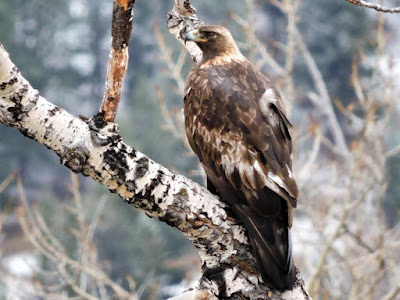We are blessed in Northeast Washington to host many Iggles on a year-round basis. During our winter months we can see many large raptors either soaring or perched on power poles, fence posts, and the branches of tall trees. We frequently see Red-tailed hawks, Rough-legged hawks, Bald eagles, and sometimes, even a genuine Golden eagle. Instinctively we know that the especially large ones are really iggles, I mean eagles. The hawks, though larger than most other birds in our area, are distinctly smaller than the eagle species. If you seem them perched close to each other the size difference is readily apparent.
What is sometime not apparent is the exact species of eagle you are looking at. Eagles take several years to develop the classic adult plumage we all recognize. Bald eagles typically don't achieve their full adult plumage until they enter their fourth year. Golden eagles also have differences between the immature and adult phases. Often, people will see an immature Bald eagle and misidentify it for a Golden eagle. This is a very common mistake. Let's see if we can sort it out.
So here's a test. One of the iggles, er..., eagles, in the photo below is a Bald eagle and the other is a Golden eagle. Do you know which one is which?
 |
| Photo courtesy the Cornell Lab of Ornithology, Macaulay Library |
I found a couple of references that might help. One is an article from Bird Watcher's Digest The author of the article identifies an unlikely landmark to look at - the wing pits. Yes, the eagle arm pits are a reliable landmark for birds soaring over head. Immature Bald eagles may not have white heads and tails, but they do have white feathers in the wing pit areas. Golden eagles do not, not matter their age.
 |
| Illustration courtesy Bird Watcher's Digest |
Bald eagles in their first year are generally all dark with white speckling on their chest. Their beak is also dark at the tip and showing only a hint of the yellow they will have as an adult. Check out the 1st year Bald eagle below, perched next to an adult. Immature Bald eagles often appear larger than the adults, likely due to the fact that their feathers are larger at this stage than the adult plumage they will eventually acquire through molting.
 |
| 1st-year on the left. Photo courtesy Bird Watcher's Digest |
2nd year Bald eagles gain a lot more white on their body, wings and tail, but it appears mottled with the overall dark-colored feathers. The head still has a dominantly dark appearance...and of course, white wing pits!
 |
| 2nd -year Bald eagle. Photo courtesy Bird Watcher's Digest |
In their 3rd year the immature Bald eagles acquire even more dark body and wing feathers, more white on their head, but not fully white. The tail remains a mix of dark and white. White in the wing pits has diminished, but still noticeable.
 |
| 3rd-year Bald eagle. Photo courtesy Bird Watcher's Digest |
How about this one?
 |
| Photo courtesy Bird Watcher's Digest |
 |
| Immature Golden eagle compared to Turkey vulture and the 3-rd year Bald eagle. Illustration courtesy Bird Watcher's Digest |
 |
| Adult Golden Eagle. Photo courtesy Bird Watcher's Daily |
Other resources for comparing photos and descriptions of the Bald and Golden eagles can be found at the Cornell Lab of Ornithology All About Birds website.
Bald Eagles and Golden Eagles
Our next blog post will deal with identifying the multiple color phases of Red-tailed hawks and Rough-legged hawks.
Good Birding!
- Hawkeye









































